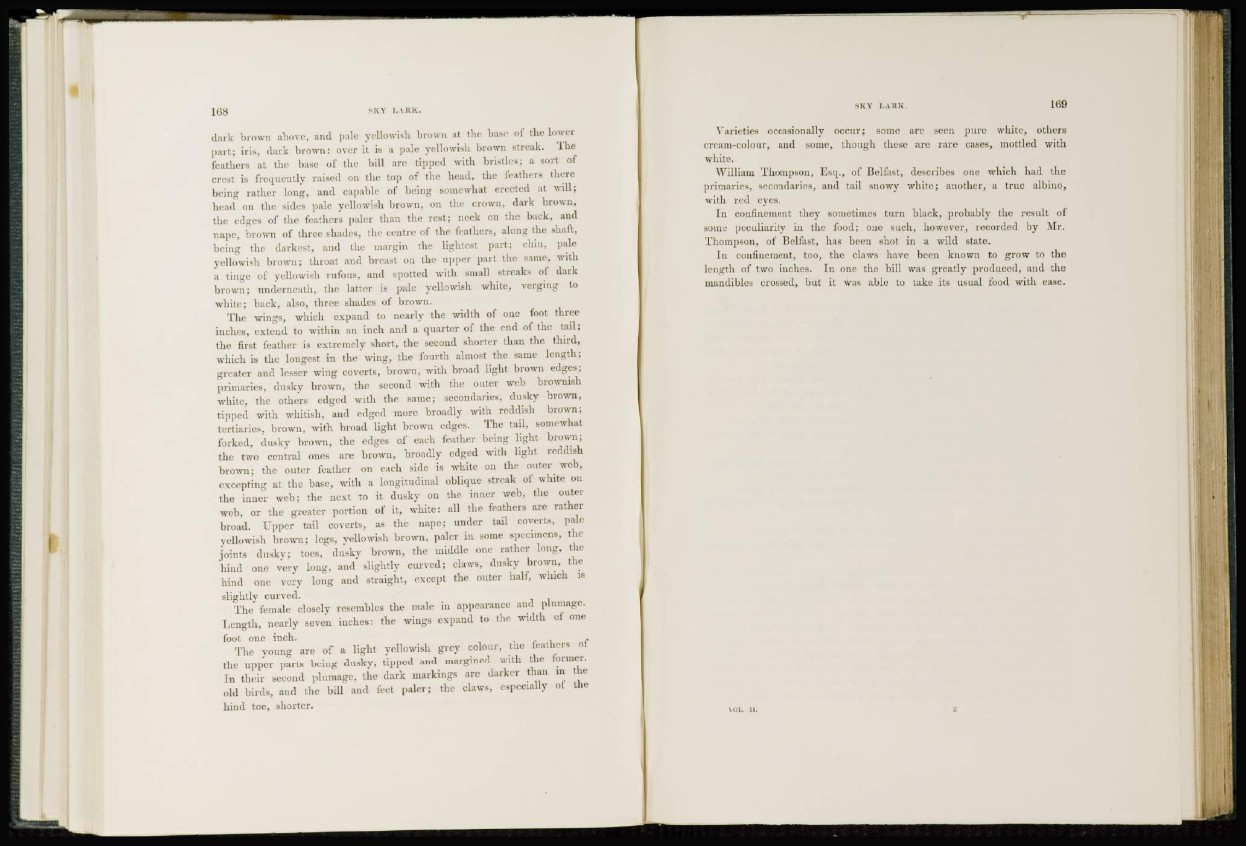
dark brown above, and pale yellowish brown at the base of the lower
PART; iris, dark brown: over it is a pale yellowish brown streak. The
feathers at the base of the bill are tipped with bristles; a sort of
crest is frequently raised on the top of the head, the feathers there
being rather long, and capable of being somewhat erected at will;
head on the sides pale yellowish In-own, on the crown, dark brown,
the edges of the feathers paler than the rest; neck on the back, and
nape, brown of three shades, the centre of the feathers, along the shaft,
being the darkest, and the margin the lightest part; chin, pale
yellowish brown; throat and breast on the upper part the same, with
a tinge of yellowish rufous, and spotted with small streaks of dark
brown; underneath, the latter is pale yellowish white, verging to
white; hack, also, three shades of brown.
The wings, which expand to nearly the width of one foot three
inches, extend to within an inch and a quarter of the end of the tail;
the first feather is extremely short, the second shorter than the third,
which is the longest in the wing, the fourth almost the same length;
greater and lesser wing coverts, brown, witli broad light brown edges;
primaries, dusky brown, the second with the outer web brownish
white, the others edged with the same; secondaries, dusky brown,
tipped with whitish, anil edged more broadly with reddish brown;
tertiaries, brown, with broad light brown edges. The tail, somewhat
forked, dusky brown, the edges of each feather being light brown;
the two central ones are brown, broadly edged with light reddish
brown; the outer feather on each side is white on the outer web,
excepting at the base, with a longitudinal oblique streak of white on
the inner web; the next to it dusky on the inner web, the outer
web, or the greater portion of it, white: all the feathers are rather
broad. Upper tail coverts, as the nape; under tail coverts, pale
yellowish brown; legs, yellowish brown, paler in some specimens, the
joints dusky; toes, dusky brown, the middle one rather long, the
hind one very long, and slightly curved; claws, dusky brown, the
hind one very long and straight, except the outer half, which is
slightly curved.
The female closely resembles the male in appearance and plumage.
Length, nearly seven inches: the wings expand to the width of one
foot one inch.
The young are of a light yellowish grey colour, the feathers of
the upper parts being dusky, tipped and margined with the former.
In their second plumage, the dark markings are darker than in the
old birds, and the bill and feet paler; the claws, especially of the
hind toe, shorter.
Varieties occasionally occur; some are seen pure white, others
cream-colour, and some, though these are rare cases, mottled with
white.
William Thompson, Esq., of Belfast, describes one which had the
primaries, secondaries, and tail snowy white; another, a true albino,
with red eyes.
In confinement they sometimes turn black, probably the result of
some peculiarity in the food; one such, however, recorded by Mr.
Thompson, of Belfast, has been shot in a wild state.
In confinement, too, the claws have been known to grow to the
length of two inches. In one the bill was greatly produced, and the
mandibles crossed, but it was able to take its usual food with ease.
\OL. n.